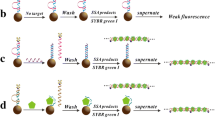Abstract
Here we present a sensitive DNA detection protocol using quantum dots (QDs) and magnetic beads (MBs) for large volume samples. In this study, QDs, conjugated with streptavidin, were used to produce fluorescent signals while magnetic beads (MBs) were used to isolate and concentrate the signals. The presence of target DNAs leads to the sandwich hybridization between the functionalized QDs, the target DNAs and the MBs. In fact, the QDs-MBs complex, which is bound using the target DNA, can be isolated and then concentrated. The binding of the QDs to the surface of the MBs was confirmed by confocal microscopy and Cd elemental analysis. It was found that the fluorescent intensity was proportional to concentration of the target DNA, while the presence of non-complementary DNA produced no significant fluorescent signal. In addition, the presence of low copies of target DNAs such as 0.5 pM in large volume samples up to 40 mL was successfully detected by using a magnet-assisted concentration protocol which consequently results in the enhancement of the sensitivity more than 100-fold.
Similar content being viewed by others
References
Taton, T. A., C. A. Mirkin, and R. L. Letsinger (2000) Scanometric DNA array detection with nanoparticle probes.Science 289: 1757–1760.
Wang, J., G. D. Liu, and A. Merkoci (2003) Electrochemical coding technology for simultaneous detection of multiple DNA targets.J. Am. Chem. Soc. 125: 3214–3215.
Yoo, S. M., K. C. Keum, S. Y. Yoo, J. Y. Choi, K. H. Chang, N. C. Yoo, W. M. Yoo, J. M. Kim, D. Lee, and S. Y. Lee (2004) Development of DNA microarray for pathogen detection.Biotechnol. Bioprocess Eng. 9: 93–99.
Li, H. X. and L. Rothberg (2004) Colorimetric detection of DNA sequences based on electrostatic interactions with unmodified gold nanoparticles.Proc. Natl. Acad. Sci. USA 101: 14036–14039.
Guedon, P., T. Livache, F. Martin, F. Lesbre, A. Roget, G. Bidan, and Y. Levy (2000) Characterization and optimization of a real-time, parallel, label-free, polypyrrole-based DNA sensor by surface plasmon resonance imaging.Anal. Chem. 72: 6003–6009.
Gerion, D., F. Q. Chen, B. Kannan, A. H. Fu, W. J. Parak, D. J. Chen, A. Majumdar, and A. P. Alivisatos (2003) Room-temperature single-nucleotide polymorphism and multiallele DNA detection using fluorescent nanocrystals and microarrays.Anal. Chem. 75: 4766–4772.
Drummond, T. G., M. G. Hill, and J. K. Barton (2003) Electrochemical DNA sensors.Nat. Biotechnol. 21: 1192–1199.
Wang, J., D. K. Xu, A. N. Kawde, and R. Polsky (2001) Metal nanoparticle-based electrochemical stripping potentiometric detection of DNA hybridization.Anal. Chem. 73: 5576–5581.
Wang, J. (2003) Nanoparticle-based electrochemical DNA detection.Anal. Chim. Acta 500: 247–257.
Park, J. W., H. S. Jung, H. Y. Lee, and T. Kawai (2005) Electrical recognition of label-free oligonucleotides upon streptavidin-modified electrode surfaces.Biotechnol. Bioprocess Eng. 10: 505–509.
Yoon, H. C. and H. S. Kim (2004) Bioelectrocatalyzed signal amplification for affinity interactions at chemically modified electrodes.Biotechnol. Bioprocess Eng. 9: 107–111.
Bruchez, M., M. Moronne, P. Gin, S. Weiss, and A. P. Alivisatos (1998) Semiconductor nanocrystals as fluorescent biological labels.Science 281: 2013–2016.
Alivisatos, A. P. (1996) Semiconductor clusters nanocrystals, and quantum dots.Science 271: 933–937.
Bailey, R. E. and S. M. Nie (2003) Alloyed semiconductor quantum dots: Tuning the optical properties without changing the particle size.J. Am. Chem. Soc. 125: 7100–7106.
Li, Y. G., Y. T. H. Cu, and D. Luo (2005) Multiplexed detection of pathogen DNA with DNA-based fluorescence nanobarcodes.Nat. Biotechnol. 23: 885–889.
Gao, X. H., W. C. W. Chan, and S. M. Nie (2002) Quantum-dot nanocrystals for ultrasensitive biological labeling and multicolor optical encoding.J. Biomed. Opt. 7: 532–537.
Ho, Y. P., M. C. Kung, S. Yang, and T. H. Wang (2005) Multiplexed hybridization detection with multicolor colocalization of quantum dot nanoprobes.Nano Lett. 5: 1693–1697.
Chan, W. C. W. and S. M. Nie (1998) Quantum dot bioconjugates for ultrasensitive nonisotopic detection.Science 281: 2016–2018.
Alivisatos, P. (2004) The use of nanocrystals in biological detection.Nat. Biotechnol. 22: 47–52.
Michalet, X., F. F. Pinaud, L. A. Bentolila, J. M. Tsay, S. Doose, J. J. Li, G. Sundaresan, A. M. Wu, S. S. Gambhir, and S. Weiss (2005) Quantum dots for live cells,in vivo imaging, and diagnostics.Science 307: 538–544.
Pumera, M., M. T. Castaneda, M. I. Pividori, R. Eritja, A. Merkoci, and S. Alegret (2005) Magnetically trigged direct electrochemical detection of DNA hybridization using Au-67 quantum dot as electrical tracer.Langmuir 21: 9625–9629.
Su, X. L. and Y. B. Li (2004) Quantum dot biolabeling coupled with immunomagnetic separation for detection ofEscherichia coli O157:H7.Anal. Chem. 76: 4806–4810.
Sun, X. L., W. X. Cui, C. Haller, and E. L. Chaikof (2004) Site-specific multivalent carbohydrate labeling of quantum dots and magnetic beads.Chembiochem 5: 1593–1596.
Nam, J. M., C. S. Thaxton, and C. A. Mirkin (2003) Nanoparticle-based bio-bar codes for the ultrasensitive detection of proteins.Science 301: 1884–1886.
Patolsky, F., Y. Weizmann, E. Katz, and I. Willner (2003) Magnetically amplified DNA assays (MADA): Sensing of viral DNA and single-base mismatches by using nucleic acid modified magnetic particles.Angew. Chem. Int. Ed. Engl. 42: 2372–2376.
Yang, L. J. and Y. B. Li (2005) Quantum dots as fluorescent labels for quantitative detection ofSalmonella typhimurium in chicken carcass wash water.J. Food Protect. 68: 1241–1245.
Author information
Authors and Affiliations
Corresponding author
Rights and permissions
About this article
Cite this article
Kim, Y.S., Kim, B.C., Lee, J.H. et al. Specific detection of DNA using quantum dots and magnetic beads for large volume samples. Biotechnol. Bioprocess Eng. 11, 449–454 (2006). https://doi.org/10.1007/BF02932313
Received:
Accepted:
Issue Date:
DOI: https://doi.org/10.1007/BF02932313




